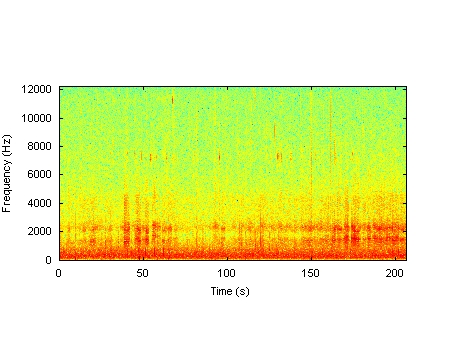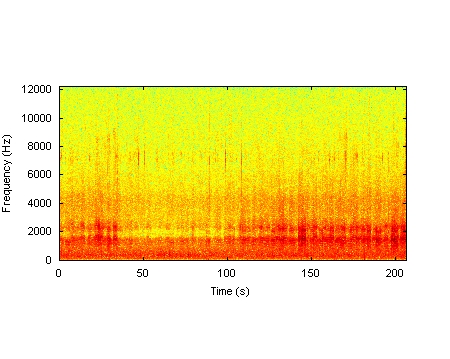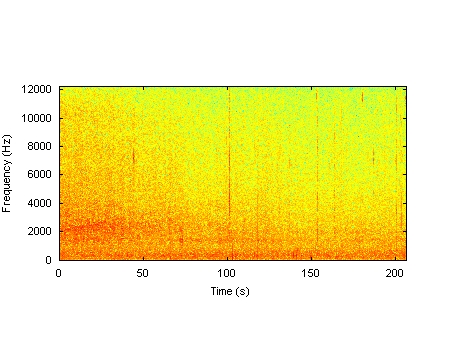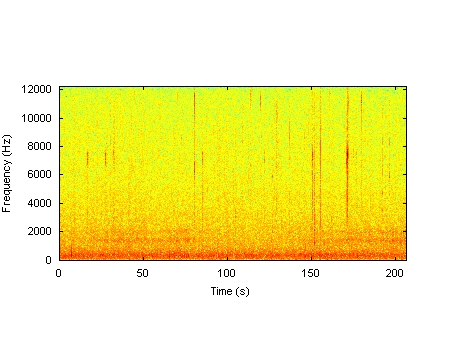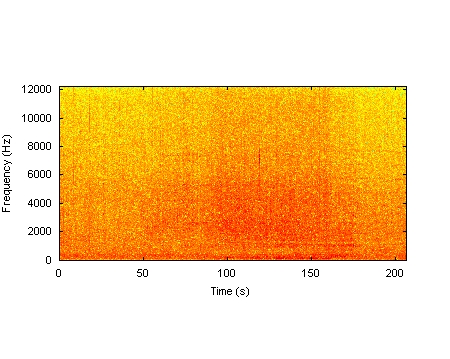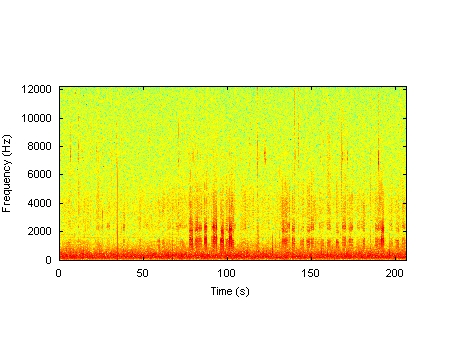
The color "spectrogram" above depicts a 10 second sound byte from the LEO 15 hydrophone, 7 kilometers off the New Jersey coast. The sounds are shown as a signal with a redder hue and quiet sounds with a greener hue. The frequency of a sound wave is seen on the vertical axis. Higher pitched sounds appear higher on the plot The duration of the sound is seen by the signal width. Listen to the wav file link to match a sound with its spectrogram signal. The signal and spectrogram are updated every 10 minutes, so click reload on your browser to hear more. Sounds may be made by boats, crabs, anchor chain, and spawning fish.
The second graph shows the "sound pressure level" (SPL) or volume over the last two days. Look for patterns in this graph as time goes by (e.g. day vs. night). Below are archived spectrograms from the last day.
Jump to:
Soniferous Fishes of the Middle Atlantic States
Past 24 Hours
| 0000 HRS
|
1200 HRS
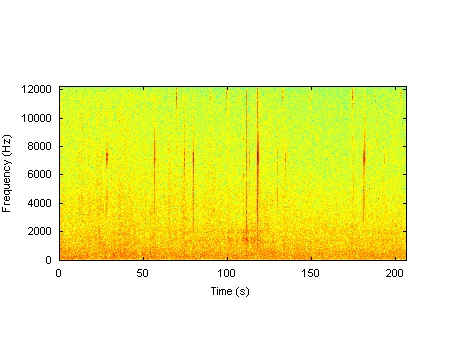 |
| 0200 HRS
|
1400 HRS
 |
| 0400 HRS
|
1600 HRS
|
| 0600 HRS
|
1800 HRS
|
| 0800 HRS
|
2000 HRS
|
| 1000 HRS
|
2200 HRS
|
Did you know that many fishes make sounds? That's right. Many grunt, croak, drum, click, and moan (Table 1). Some fishes are named for this ability: The Drums (Family Sciaenidae) have special muscles to drum their swimbladders like a kettledrum. This family includes such east coast species as Atlantic croaker, black drum, red drum, weakfish, kingfish, spotted seatrout, silver perch, and spot. Grunts (Family Haemulidae) grind their throat teeth (called a pharyngeal mill). Males most often produce the sounds to demonstrate their size and health to females. It works well when you consider that spawning (shedding eggs and sperm) often happens at night and in very murky water. A bigger fish has a bigger swimbladder so sounds resonate deeper, and the strength and repetition rate can tell a listening female about her suitor's health and can also tell her where he is. This helps her make a choice regarding who would pass the best genes to her offspring.
The fact that the amount of fish noise is related to the number of fish in an area as well as their likelihood to spawn gives us a powerful tool to survey spawning activity 24 hours a day, seven days a week, year-round without disturbing them. Put a hydrophone (underwater microphone) in the water and listen! In this project, the National Undersea Research Program has helped scientists from the Rutgers University Marine Field Station and the University of South Florida College of Marine Science to develop an observatory off the New Jersey coast to examine the seasonality, timing, and depth distribution for several soniferous fish species. A number of hydrophones are arranged in a cross-shape to listen in shallow and deep water, close to the shore and farther away (Figure 1). A computer can tell the species apart based on their sounds. Most are anchored on the bottom to record for several months at a time and retrieved later, but one is live. These hydrophones are in the same area in which another observatory, LEO-15 within the Jacques Cousteau National Estuarine Research Reserve, keeps track of physical factors such as current speed and direction, salinity, temperature, light penetration (clarity), and sea level from tide and wind forcing. Putting the sound data together with the physical data allows us to map what is important to these fish. Occasional sampling for eggs with plankton nets can verify that the fish are spawning, not just trying.
There are two types of hydrophones, live and logging (recording). Live hydrophones (HTI-96min by High Tech Inc.) are linked to cable at the LEO-15 underwater communication node and are streamed to the Rutgers University Marine Field Station of the Institute of Marine and Coastal Science. Recording systems are made by Loggerhead Instruments. Currently, they listen for ten seconds every minute and record sounds as wav files, but the record/sleep pattern can be easily changed. This allows the batteries to last for two months. The sound files from both kinds of hydrophones are passed through a computer program that filters the digital code for patterns that match those made by a number of spawning fish.
Hydrophones on board the RV Arabella await deployment
Dr. David Mann, University of South Florida
Dr. Thomas Grothues, Rutgers University
This research is possible through a grant from the National Undersea Research Program (NURP)
